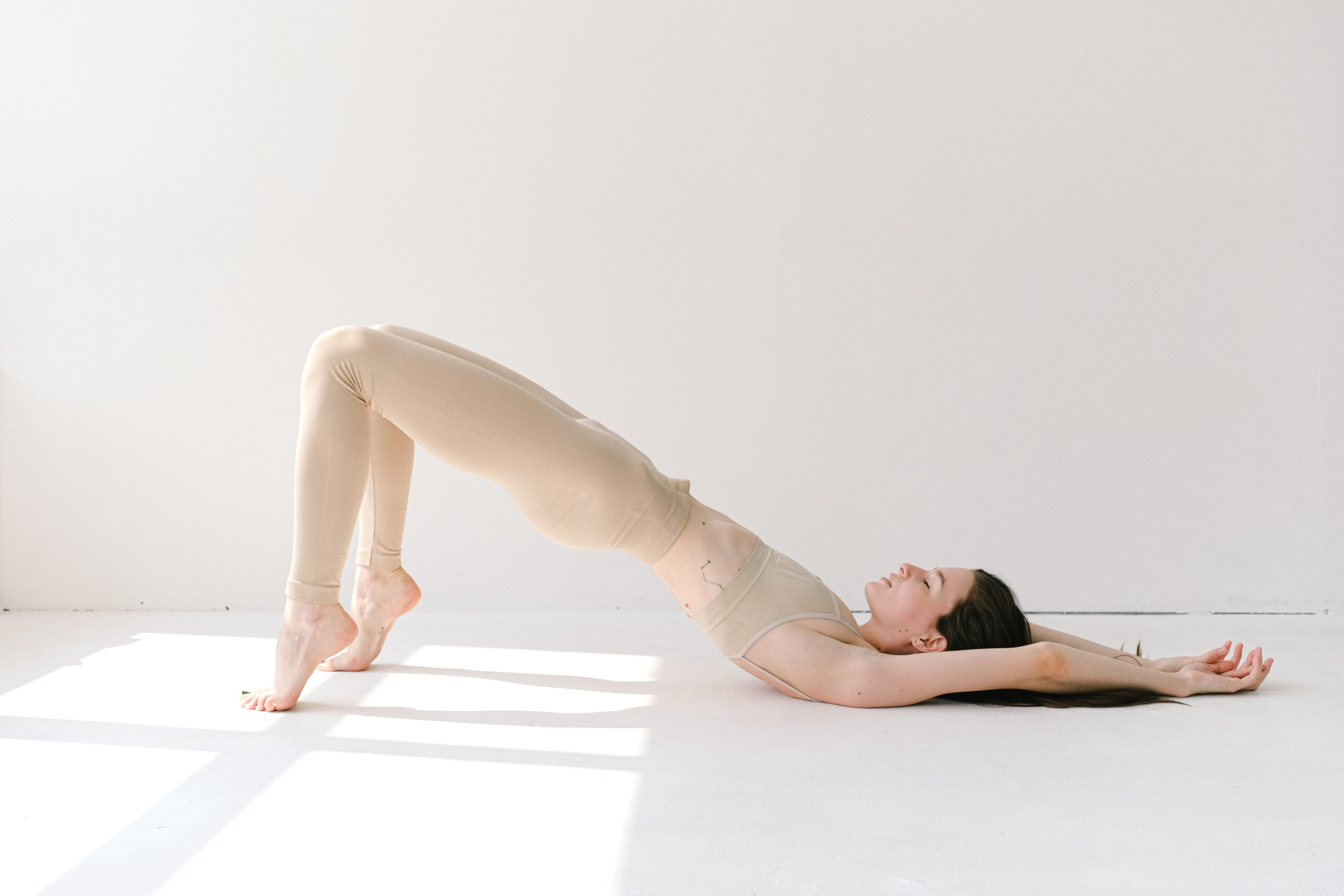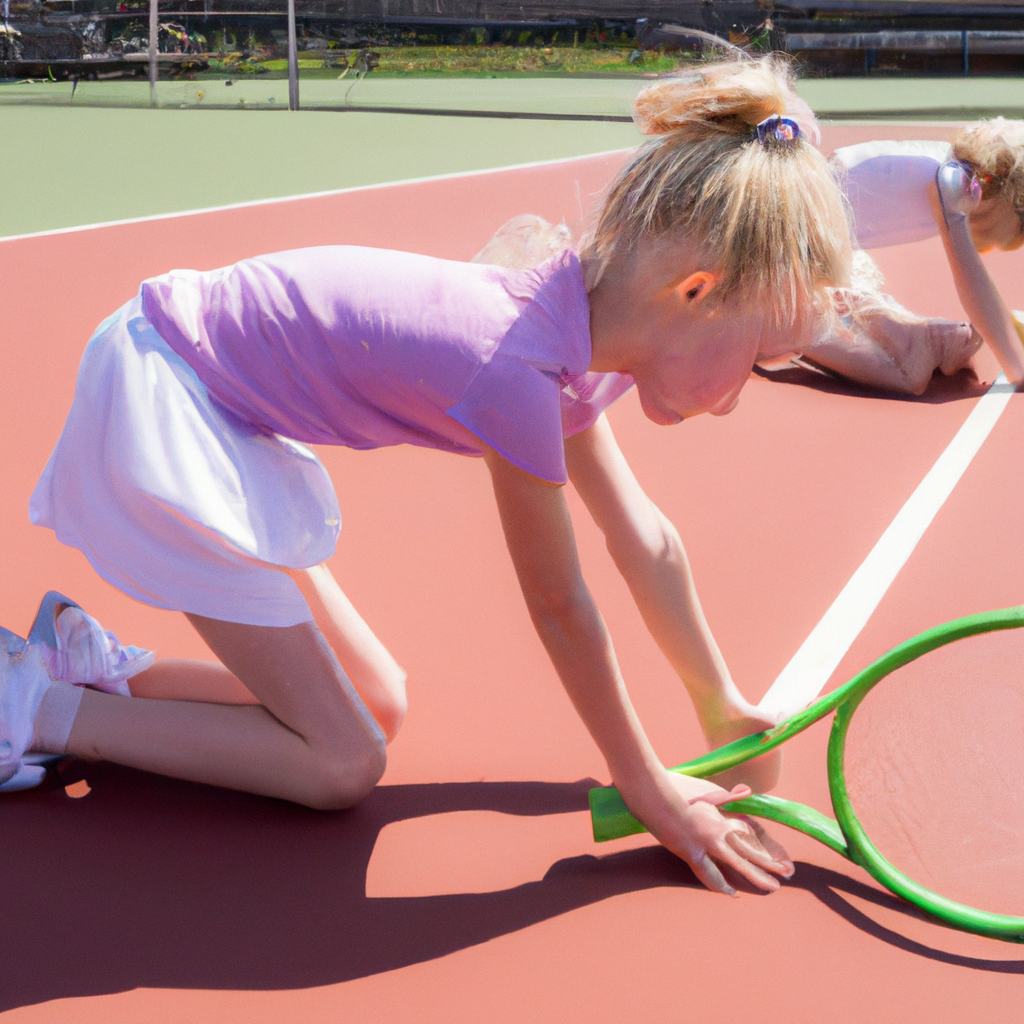Are your kids interested in playing tennis? If so, you might be wondering if there are any specific stretches they should do before hitting the court. Well, you’re in luck! In this short article, we will explore the importance of stretching for young tennis players and highlight some specific stretches that can help improve their performance and prevent injuries. So, grab a racket and let’s get stretching!
Warm-Up Stretches
Importance of Warm-Up
Before you jump into your tennis game, it’s important to take a few minutes to warm up your body and prepare it for physical activity. A proper warm-up routine helps increase blood flow, loosens up your muscles, and improves your flexibility. It also reduces the risk of injury during play and enhances your performance on the court. So, let’s take a look at some warm-up stretches that will get you ready to ace your game!
Arm Circles
To start off, we have arm circles. Stand with your feet shoulder-width apart and extend your arms out to the sides. Slowly rotate your arms in small circles, gradually increasing the size of the circles. This exercise helps mobilize the shoulder joints, improves circulation, and warms up the muscles in your arms. Make sure to perform this stretch in both clockwise and counterclockwise directions for maximum benefit.
Shoulder Rolls
Next up, we have shoulder rolls. Simply stand with your feet shoulder-width apart and relax your arms by your sides. Begin by rolling your shoulders forward in a circular motion, making sure to keep your movements fluid and controlled. After a few rotations, switch to rolling your shoulders backward. This stretch helps to release tension in the shoulder area, increases range of motion, and prepares your shoulders for the movements involved in a game of tennis.
Arm Swings
Now let’s move on to arm swings, which are great for warming up your upper body. Stand with your feet shoulder-width apart and extend your arms out to the sides. Start swinging your arms forward and backward in a controlled manner. Gradually increase the range of motion and speed as you continue. This exercise helps to loosen up your shoulders and upper back, improving your overall upper body flexibility and preparing you for the forehands and backhands you’ll be executing on the court.
Hip Circles
Lastly, we have hip circles, an excellent warm-up stretch for your lower body. Stand with your feet shoulder-width apart and gently place your hands on your hips. Begin by making small circles with your hips in a clockwise direction. After a few rotations, switch to counterclockwise direction. This exercise helps to loosen up your hip joints, increases flexibility in your hips and lower back, and prepares you for quick lateral movements and powerful serves in a game of tennis.
Upper Body Stretches
Neck Stretches
Moving on to upper body stretches, let’s start with the neck. Stand tall with your feet shoulder-width apart and gently tilt your head towards your right shoulder, feeling a stretch on the left side of your neck. Hold this position for 15-20 seconds, then slowly bring your head back to the center. Repeat the stretch on the left side, tilting your head towards your left shoulder. This stretch helps to release tension in the neck muscles, improves neck mobility, and reduces the risk of neck strains during tennis.
Shoulder Stretches
Next up, we have shoulder stretches. Stand with your feet shoulder-width apart and extend your right arm straight across your chest, holding it in place with your left hand above your elbow. Gently pull your right arm towards your left shoulder, feeling a stretch in your right shoulder and the back of your upper arm. Hold this position for 15-20 seconds, then release and repeat the stretch on your left arm. Shoulder stretches help improve shoulder mobility, alleviate tightness, and prevent shoulder injuries while playing tennis.
Chest Stretches
Now let’s focus on stretching your chest muscles. Stand tall with your feet shoulder-width apart and interlace your fingers behind your back. Straighten your arms and lift them away from your body, feeling a stretch across your chest. Hold this position for 15-20 seconds, then release. This stretch helps to open up your chest, improve posture, and counteract the forward shoulder position often seen in tennis players.
Arm Stretches
To complete the upper body stretches, we’ll work on stretching your arms. Stand with your feet shoulder-width apart and extend your right arm straight out in front of you. Use your left hand to gently pull your right fingers back towards your body until you feel a stretch in your forearm. Hold for 15-20 seconds, then release and repeat the stretch on your left arm. This stretch targets the muscles in your forearms, which are crucial for gripping and swinging the tennis racket.

Lower Body Stretches
Quadriceps Stretches
Now let’s move on to lower body stretches, starting with your quadriceps. Stand tall with your feet hip-width apart and bring your right heel towards your buttocks, grabbing your ankle with your right hand. Gently pull your heel towards your buttocks until you feel a stretch in the front of your thigh. Hold this position for 15-20 seconds, then release and repeat the stretch on your left leg. Quadriceps stretches help improve flexibility in your thighs, which is essential for running, jumping, and executing quick movements on the tennis court.
Hamstring Stretches
Next up, we have hamstring stretches. Find a comfortable spot on the ground and sit with your legs extended straight in front of you. Bend your right knee and slide your right foot towards your inner thigh. With a straight back, reach forward towards your left foot, aiming to touch your toes. Hold this position for 15-20 seconds, then release and repeat the stretch on your right leg. Hamstring stretches increase flexibility in the back of your thighs, allowing for better stride length and reducing the risk of hamstring strains.
Calf Stretches
Moving down to your calf muscles, stand facing a wall with your feet hip-width apart. Lean forward, placing your hands on the wall for support. Take a step back with your right foot, keeping it flat on the ground. Gently bend your left knee and lean forward, feeling a stretch in your right calf. Hold for 15-20 seconds, then switch legs and repeat the stretch on your left calf. Calf stretches help improve flexibility in your lower legs, which is crucial for explosive movements and maintaining balance in tennis.
Hip Stretches
Lastly, we have hip stretches. Lie down on your back with your legs extended straight. Bend your right knee and bring it towards your chest, holding it in place with both hands. Gently pull your right knee across your body towards your left shoulder, feeling a stretch in your outer hip and glute area. Hold for 15-20 seconds, then release and repeat the stretch on your left side. Hip stretches improve hip mobility, increase range of motion, and help prevent hip-related injuries on the tennis court.
Full Body Stretches
Lunges
We’ve covered the upper and lower body stretches, and now it’s time to move on to full body stretches. Lunges are a great exercise for stretching multiple muscle groups at once. Start by standing with your feet hip-width apart. Take a big step forward with your right foot and bend your right knee until it forms a 90-degree angle. Keep your left leg straight behind you with your heel lifted off the ground. Hold this lunge position for 15-20 seconds, then switch legs and repeat the stretch. Lunges stretch your hips, quadriceps, hamstrings, and calf muscles, ensuring that your entire lower body is warmed up and ready for a game of tennis.
Trunk Rotations
Next up, we have trunk rotations to stretch your core muscles and improve spinal flexibility. Stand tall with your feet shoulder-width apart and place your hands on your hips. Slowly rotate your upper body to the right, keeping your lower body stable. Return to the center and repeat the rotation to the left side. This exercise helps warm up your back, abdominals, and obliques, allowing for better rotation and stability during tennis strokes.
Side Bends
For another full body stretch, try side bends. Stand with your feet shoulder-width apart and extend your right arm overhead. Gently slide your right hand down your right leg, aiming to touch your knee or shin. Hold this position for 15-20 seconds, then switch sides and repeat the stretch. Side bends stretch your side muscles, including the obliques and latissimus dorsi, helping to improve lateral movements and overall flexibility.
Toe Touches
Lastly, let’s focus on toe touches to stretch your hamstrings, lower back, and calves. Stand with your feet hip-width apart and slowly bend forward from your hips, aiming to touch your toes with your fingertips. If you can’t reach your toes, that’s okay! Just go as far as you comfortably can while maintaining a slight bend in your knees. Hold the stretch for 15-20 seconds, then slowly roll back up to a standing position. Toe touches help increase flexibility in your posterior chain muscles, which are essential for powerful movements on the tennis court.

Flexibility Training
Benefits of Flexibility
Now that you’re familiar with various stretching exercises, let’s explore the benefits of flexibility training for tennis players. Flexibility is an essential component of overall fitness and plays a crucial role in your tennis performance. By incorporating regular flexibility training into your routine, you can expect:
- Increased Range of Motion: Flexibility exercises help improve your joint flexibility, allowing for a greater range of motion. This, in turn, enhances your ability to execute tennis strokes with proper technique and power.
- Injury Prevention: Flexible muscles and joints are less prone to injuries, as they are more adaptable to physical stress. By maintaining good flexibility, you reduce the risk of strains, sprains, and other common tennis injuries.
- Enhanced Performance: Proper flexibility allows you to move more efficiently on the court, improving your agility, speed, and balance. It also helps optimize muscle function, enabling you to generate more power in your shots and move with greater ease.
- Postural Alignment: Flexibility training helps correct imbalances in your muscles and promotes proper postural alignment. This is particularly beneficial for tennis players who often experience muscle imbalances due to the repetitive nature of the sport.
Dynamic Stretches
When it comes to flexibility training for tennis, incorporating dynamic stretches into your routine is highly beneficial. Unlike static stretches (which we’ll discuss next), dynamic stretches involve movement and can be specific to the demands of tennis. Dynamic stretching helps warm up your muscles, increases blood flow, and improves muscular coordination. Some examples of dynamic stretches for tennis players include high knees, butt kicks, trunk rotations with arm swings, and walking lunges.
Static Stretches
Static stretches, on the other hand, involve holding a stretch for an extended period. While dynamic stretches are great for warm-up, static stretches are better suited for the cool-down phase of your tennis session. Static stretching helps improve flexibility by lengthening your muscles and connective tissues. It’s important to hold each static stretch for 15-30 seconds without bouncing or pain, allowing your muscles to relax and elongate. Examples of static stretches include the ones we discussed earlier for individual muscle groups.
Proprioceptive Neuromuscular Facilitation (PNF)
In addition to dynamic and static stretches, another flexibility training technique worth exploring is Proprioceptive Neuromuscular Facilitation (PNF). PNF involves a combination of stretching and contracting specific muscle groups to enhance flexibility. This approach is often used with the help of a partner or resistance equipment. PNF stretching can be effective for improving flexibility in cases where static stretching alone may not be yielding the desired results.
Stretching Routine
Pre-Practice Stretching
Now that you have a good grasp of different stretching exercises and flexibility training, let’s discuss how to incorporate them into a stretching routine for various occasions. For pre-practice stretching, it’s important to focus on dynamic stretches that warm up your muscles and prepare your body for the physical demands of practice. Begin with a light cardiovascular warm-up, such as light jogging or jumping jacks, to increase blood flow and raise your body temperature. Then, perform dynamic stretches that target the major muscle groups used in tennis, such as arm swings, lunges, trunk rotations, and hip circles. Perform each dynamic stretch for about 10-12 repetitions, gradually increasing the range of motion.
Post-Practice Stretching
After your practice session, it’s vital to cool down your body and perform stretches that help your muscles recover and prevent tightness. Start with a gentle jog or walk to bring your heart rate down gradually. Then, transition to static stretches that target the specific muscles you worked during practice. Hold each stretch for 15-30 seconds, focusing on relaxing and breathing deeply. This post-practice stretching routine helps lengthen and relax your muscles, promoting recovery, and reducing muscle soreness.
Pre-Match Stretching
Before a tennis match, it’s crucial to prepare your body for the intense physical activity ahead. Begin with a light cardiovascular warm-up, such as jumping jacks or skipping rope, to elevate your heart rate and warm up your muscles. Afterward, switch to static stretches to gently elongate your muscles and improve their flexibility. Focus on stretching your major muscle groups, including your shoulders, chest, hips, quadriceps, and calves. Hold each stretch for 15-30 seconds, going to the point of tension without causing pain. This pre-match stretching routine helps activate your muscles, increase range of motion, and mentally prepare you for the game.
Post-Match Stretching
After a tennis match, your body needs time to cool down and recover from the physical exertion. Similar to the post-practice stretching routine, start with a gentle jog or walk to gradually decrease your heart rate. Then, move into static stretches that target the muscles that were utilized the most during the match. Pay special attention to stretching your shoulder muscles, wrists, ankles, knees, and lower back. Hold each stretch for 15-30 seconds, focusing on relaxation and allowing your muscles to recover and release any tension. This post-match stretching routine aids in muscle recovery, reduces post-match soreness, and helps prevent any potential muscle imbalances.
Injury Prevention Stretches
Wrist Stretches
Tennis involves repetitive wrist movements, such as gripping the racket and executing strokes. It’s essential to take care of your wrists and keep them flexible to prevent overuse injuries. To stretch your wrists, extend your right arm in front of you with your palm facing down. Using your left hand, gently pull your fingers back towards your body until you feel a stretch in your wrist. Hold for 15-20 seconds, then release and repeat on your left wrist. This stretch helps maintain flexibility in the wrist joints, reducing the risk of wrist strains and tendinitis.
Ankle Stretches
Strong and flexible ankles are vital for stability and quick movements on the tennis court. To stretch your ankles, sit on the ground with both legs extended in front of you. Bend your right knee and cross your right ankle over your left thigh. With your right hand, gently press down on your right knee, feeling a stretch in your right ankle. Hold for 15-20 seconds, then switch legs and repeat the stretch on your left ankle. Ankle stretches improve ankle range of motion, prevent ankle sprains, and enhance overall footwork on the tennis court.
Knee Stretches
For the knees, it’s important to focus on maintaining flexibility and stability. Start by standing tall and lift your right foot towards your buttocks, bending your knee. Use your hand to gently pull your foot towards your buttocks until you feel a stretch in your quadriceps and the front of your knee. Hold for 15-20 seconds, then release and repeat the stretch on your left leg. Knee stretches help keep your quadriceps flexible, reduce muscle imbalances, and mitigate the risk of knee injuries during tennis.
Shoulder Stretches
Lastly, let’s not forget about the shoulders, which are heavily involved in tennis movements. Stand with your feet shoulder-width apart and extend your right arm across your body. With your left hand, gently pull your right arm towards your chest until you feel a stretch in your shoulder and the back of your upper arm. Hold for 15-20 seconds, then release and repeat the stretch on your left arm. Shoulder stretches promote shoulder mobility, prevent muscular imbalances, and reduce the risk of common shoulder injuries in tennis.
Cool-Down Stretches
Cool-Down Importance
Just as warming up is essential, a proper cool-down is equally important for a successful tennis routine. Cooling down helps gradually lower your heart rate, prevent blood pooling, and aid in your body’s recovery post-activity. As part of your cool-down, it’s beneficial to include gentle stretches that promote relaxation and muscle recovery.
Gentle Jogging/Walking
To start your cool-down, engage in gentle jogging or walking to gradually bring your heart rate down. This allows for a smooth transition from intense physical activity to a more relaxed state. Decrease your pace slowly, and focus on deep breathing to promote relaxation.
Tricep Stretches
Now let’s move on to tricep stretches, which target the muscles at the back of your upper arms. Extend your right arm straight up overhead, then bend your elbow and drop your right hand towards your upper back. With your left hand, gently push your right elbow downwards until you feel a stretch in your tricep. Hold for 15-20 seconds, then repeat the stretch on your left arm. Tricep stretches help release tension in your upper arms, reduce muscle soreness, and aid in the recovery process.
Butterfly Stretch
To complete your cool-down, perform the butterfly stretch to stretch your inner thigh and groin muscles. Sit on the ground, bend your knees, and bring the soles of your feet together. Gently press your knees towards the ground, feeling a stretch in your inner thighs. Hold this position for 15-20 seconds, focusing on relaxing your muscles and taking deep breaths. The butterfly stretch helps improve flexibility in your hips, promotes muscle recovery, and enhances overall relaxation after a tennis session.
Stretching Tips for Kids
Age-Appropriate Stretches
When it comes to stretching for kids, it’s important to consider age-appropriate exercises. Younger children may have less developed muscles and joints, so their stretches should be gentle and focus on basic movements. As children grow older and progress in their tennis training, their stretches can become more advanced and targeted. It’s crucial to adapt the stretches to each child’s individual needs and ensure they are performing them with proper technique and supervision.
Gradual Progression
Just like adults, kids should also focus on gradual progression when it comes to stretching. Starting with simple stretches and gradually increasing the difficulty and intensity over time allows their muscles and joints to adapt and improve flexibility gradually. This gradual progression supports healthy growth and development while reducing the risk of injury.
Proper Technique
Teaching kids proper stretching technique is essential to ensure they get maximum benefit while minimizing the risk of injury. Emphasize the importance of proper form and technique during stretches, including maintaining proper alignment, not bouncing or jerking during stretches, and breathing deeply throughout. Demonstrating the stretches and providing verbal cues can help kids understand and perform them correctly.
Incorporating Fun and Games
To make stretching enjoyable for kids, incorporate fun and games into their routine. Consider turning stretches into playful activities, such as “reach for the stars” where they stretch their arms overhead as high as they can or “butterfly wings” where they flap their arms like butterfly wings during the butterfly stretch. By making stretching fun, you can create a positive association with it and encourage kids to incorporate it into their regular tennis practice.
Professional Guidance
Sports Coach or Trainer
If you or your child is serious about tennis and want to ensure that your stretching routine is tailored to your specific needs, seeking the guidance of a qualified sports coach or trainer is highly recommended. A professional in the field can assess your current flexibility, analyze your tennis movements, and provide personalized guidance on the most suitable stretches for your individual requirements. They can also monitor your progress and make adjustments to your stretching routine as needed.
Physical Therapist
In some cases, seeking guidance from a physical therapist may be beneficial, especially if you have pre-existing injuries or specific physical limitations. A physical therapist can perform a thorough evaluation, provide targeted stretches to aid in injury recovery, and offer additional exercises to strengthen specific muscles or address imbalances. They can also provide valuable guidance on injury prevention techniques and help promote long-term musculoskeletal health.
Assessing Individual Needs
Whether you’re a beginner or an experienced tennis player, it’s important to assess your individual flexibility needs and take steps to improve your areas of weakness. Pay attention to any tightness or limitations in your movement patterns during tennis practice, as these can indicate areas that require more attention in your stretching routine. Working with a sports coach, trainer, or physical therapist can help identify these areas and tailor your stretching routine to address them effectively.
Monitoring Progress
Lastly, it’s essential to monitor your progress as you incorporate stretching into your tennis routine. Keep track of your flexibility improvements over time, notice any changes in your range of motion, and observe how your body feels during and after activities. Regularly reassessing your stretching routine and consulting with a professional can help ensure that you continue to progress and prevent any potential setbacks.
In conclusion, incorporating a comprehensive stretching routine into your tennis training is essential for maximizing performance, preventing injuries, and promoting overall musculoskeletal health. By following a warm-up routine that includes dynamic stretches, targeting different muscle groups with both upper and lower body stretches, and utilizing a variety of stretching techniques, you can enhance your flexibility and improve your game. Remember to customize your stretching routine based on your specific needs, age, and fitness level. If possible, seek professional guidance to ensure proper technique, individualized stretching plans, and ongoing monitoring of your progress. So, get out there, warm up, stretch it out, and enjoy your time on the tennis court!



